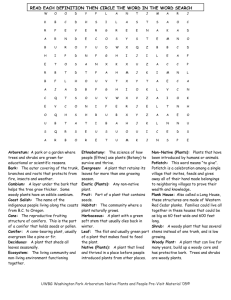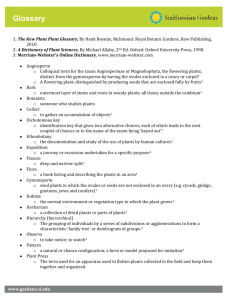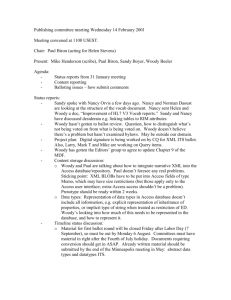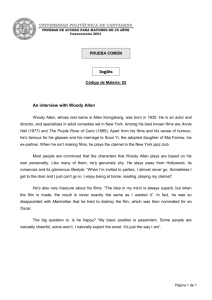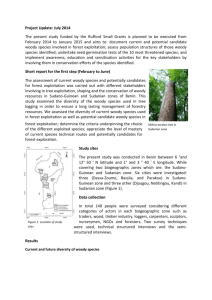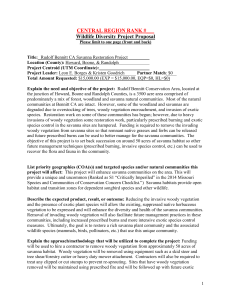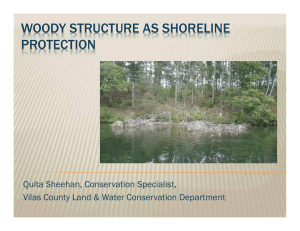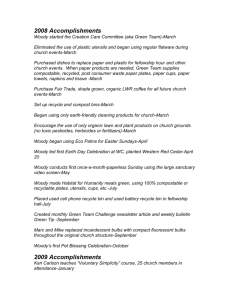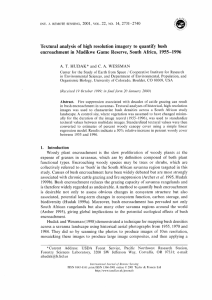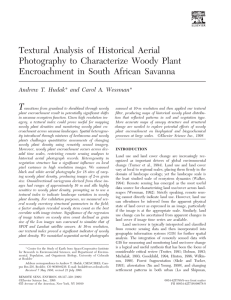RELATIONSHIPS BETWEEN FIRE FREQUENCY AND WOODY Andrew T. Hudak
advertisement
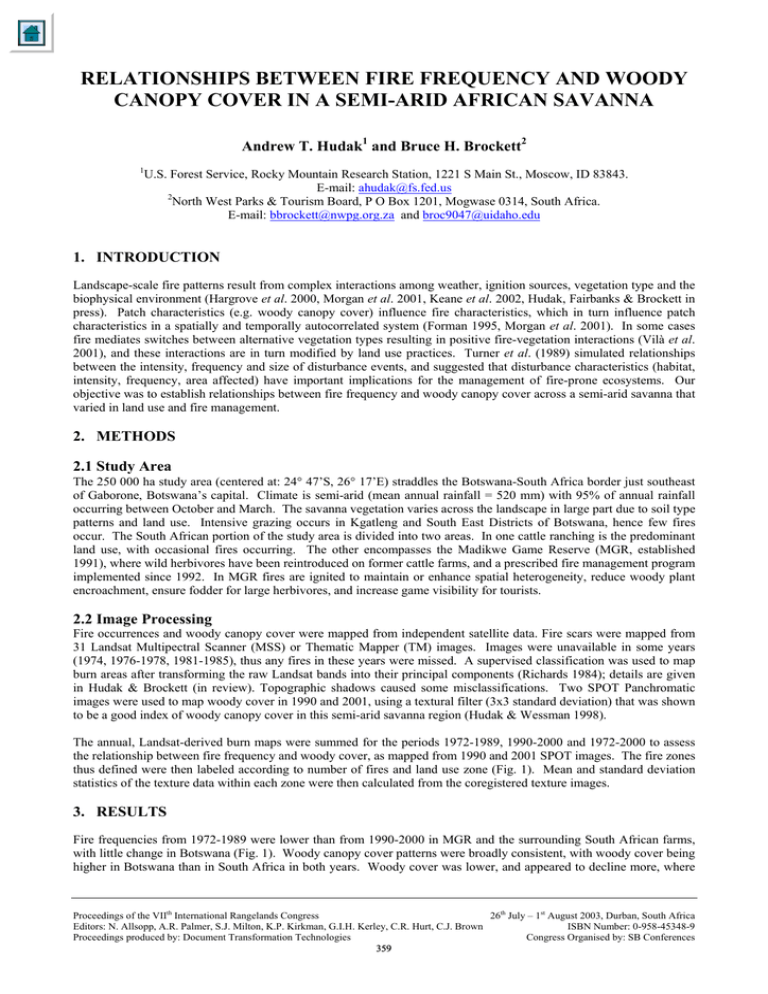
RELATIONSHIPS BETWEEN FIRE FREQUENCY AND WOODY CANOPY COVER IN A SEMI-ARID AFRICAN SAVANNA Andrew T. Hudak1 and Bruce H. Brockett2 1 U.S. Forest Service, Rocky Mountain Research Station, 1221 S Main St., Moscow, ID 83843. E-mail: ahudak@fs.fed.us 2 North West Parks & Tourism Board, P O Box 1201, Mogwase 0314, South Africa. E-mail: bbrockett@nwpg.org.za and broc9047@uidaho.edu 1. INTRODUCTION Landscape-scale fire patterns result from complex interactions among weather, ignition sources, vegetation type and the biophysical environment (Hargrove et al. 2000, Morgan et al. 2001, Keane et al. 2002, Hudak, Fairbanks & Brockett in press). Patch characteristics (e.g. woody canopy cover) influence fire characteristics, which in turn influence patch characteristics in a spatially and temporally autocorrelated system (Forman 1995, Morgan et al. 2001). In some cases fire mediates switches between alternative vegetation types resulting in positive fire-vegetation interactions (Vilà et al. 2001), and these interactions are in turn modified by land use practices. Turner et al. (1989) simulated relationships between the intensity, frequency and size of disturbance events, and suggested that disturbance characteristics (habitat, intensity, frequency, area affected) have important implications for the management of fire-prone ecosystems. Our objective was to establish relationships between fire frequency and woody canopy cover across a semi-arid savanna that varied in land use and fire management. 2. METHODS 2.1 Study Area The 250 000 ha study area (centered at: 24° 47’S, 26° 17’E) straddles the Botswana-South Africa border just southeast of Gaborone, Botswana’s capital. Climate is semi-arid (mean annual rainfall = 520 mm) with 95% of annual rainfall occurring between October and March. The savanna vegetation varies across the landscape in large part due to soil type patterns and land use. Intensive grazing occurs in Kgatleng and South East Districts of Botswana, hence few fires occur. The South African portion of the study area is divided into two areas. In one cattle ranching is the predominant land use, with occasional fires occurring. The other encompasses the Madikwe Game Reserve (MGR, established 1991), where wild herbivores have been reintroduced on former cattle farms, and a prescribed fire management program implemented since 1992. In MGR fires are ignited to maintain or enhance spatial heterogeneity, reduce woody plant encroachment, ensure fodder for large herbivores, and increase game visibility for tourists. 2.2 Image Processing Fire occurrences and woody canopy cover were mapped from independent satellite data. Fire scars were mapped from 31 Landsat Multipectral Scanner (MSS) or Thematic Mapper (TM) images. Images were unavailable in some years (1974, 1976-1978, 1981-1985), thus any fires in these years were missed. A supervised classification was used to map burn areas after transforming the raw Landsat bands into their principal components (Richards 1984); details are given in Hudak & Brockett (in review). Topographic shadows caused some misclassifications. Two SPOT Panchromatic images were used to map woody cover in 1990 and 2001, using a textural filter (3x3 standard deviation) that was shown to be a good index of woody canopy cover in this semi-arid savanna region (Hudak & Wessman 1998). The annual, Landsat-derived burn maps were summed for the periods 1972-1989, 1990-2000 and 1972-2000 to assess the relationship between fire frequency and woody cover, as mapped from 1990 and 2001 SPOT images. The fire zones thus defined were then labeled according to number of fires and land use zone (Fig. 1). Mean and standard deviation statistics of the texture data within each zone were then calculated from the coregistered texture images. 3. RESULTS Fire frequencies from 1972-1989 were lower than from 1990-2000 in MGR and the surrounding South African farms, with little change in Botswana (Fig. 1). Woody canopy cover patterns were broadly consistent, with woody cover being higher in Botswana than in South Africa in both years. Woody cover was lower, and appeared to decline more, where Proceedings of the VIIth International Rangelands Congress 26th July – 1st August 2003, Durban, South Africa Editors: N. Allsopp, A.R. Palmer, S.J. Milton, K.P. Kirkman, G.I.H. Kerley, C.R. Hurt, C.J. Brown ISBN Number: 0-958-45348-9 Proceedings produced by: Document Transformation Technologies Congress Organised by: SB Conferences 359 fire frequency increased; this was especially the case in MGR (Fig. 1). Mean image texture in 2001 declined as the number of fires increased over the full 1972-2000 fire scar mapping period (Fig. 2). Image Texture (17 May 2001) Figure 1. Map of study area location, with number of fires during periods a) 1972-1989 and b) 1990-2000 compared to subsequent woody cover (as indicated by image texture) in c) 1990 and d) 2001. 2.5 Madikwe Game Reserve 2 South African Farms Botswana 1.5 1 0.5 0 0 1 2 3 4 5 6 7 8 Number of Fires (1972-2000) Figure 2. Mean (+SE) image texture in 2001 in relation to number of fires during the preceding 1972-2000 period. 4. DISCUSSION It is probable that we missed some fires, especially for those years when Landsat data were unavailable. Nevertheless, we had sufficient data to indicate an inverse relationship between fire frequency and woody canopy cover in this semiarid savanna. The similar patterning between fires and woody cover (Fig. 1) reflects known patterns in landscape composition and is supported by field observations. We did not, however, have field measurements of woody cover, so we could only map and measure relative, not absolute, woody cover and woody cover change. In addition to relating woody canopy cover to fire frequency we could relate it to time-since-fire, which may indicate nested hierarchical relationships with fire severity. Spatial models also can be used to characterize fire regimes in 360 relation to climate (Rupp, Chapin & Starfield 2000), topography, landscape composition and land use practice (Keane, Parsons & Hessburg 2002, Perry & Enright 2002). A goal is to use these empirical relationships to guide development of mechanistic models (e.g. cellular automata), to more fully explore fire and vegetation interactions for the mutual benefit of ecologists and managers. 5. REFERENCES Forman RTT 1995. Land Mosaics: The Ecology of Landscapes and Regions. Cambridge University Press, New York, pp. 351-363. Hargrove WW, Gardner RH, Turner MG, Romme WH & Despain DG 2000. Simulating fire patterns in heterogeneous landscapes. Ecological Modelling 135: 243-263. Hudak AT & Brockett BH. A methodology for mapping the fire history of a southern African savanna from Landsat imagery. International Journal of Remote Sensing, in review. Hudak AT, Fairbanks DHK & Brockett BH. Trends in fire patterns in a southern African savanna under alternative land use practices. Agriculture, Ecosystems & Environment, in press. Hudak AT & Wessman, CA 1998. Textural analysis of historical aerial photography to characterize woody plant encroachment in South African savanna. Remote Sensing of Environment 66: 317-330. Keane RE, Parsons RA & Hessburg PF 2002. Estimating historical range and variation of landscape patch dynamics: limitations of the simulation approach. Ecological Modelling 151: 29-49. Morgan P, Hardy CC, Swetnam TW, Rollins MG & Long DG 2001. Mapping fire regimes across time and space: understanding coarse and fine-scale fire patterns. International Journal of Wildland Fire 10: 329-342. Perry GLW & Enright NJ 2002. Humans, fire and landscape pattern: understanding a maquis-forest complex, Mont Do, New Caledonia, using a spatial 'state-and-transition' model. Journal of Biogeography 29: 1143-1158. Richards JA 1984. Thematic mapping from multitemporal image data using the principal components transformation. Remote Sensing of Environment 16: 35-46. Rupp TS, Chapin FS & Starfield AM 2000. Response of subarctic vegetation to transient climatic change on the Seward Peninsula in north-west Alaska. Global Change Biology 6: 541-555. Turner MG, Gardner RH, Dale VH & O’Neill RV 1989. Predicting the spread of disturbance across heterogeneous landscapes. Oikos 55: 121-129. Vilà M, Lloet F, Ogheri E & Terradas J 2001. Positive fire-grass feedback in Mediterranean Basin woodlands. Forest Ecology and Management 147: 3-14. 361
